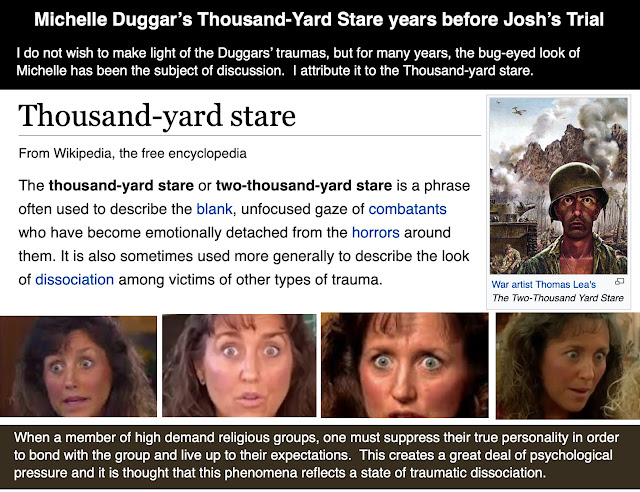 |
| Photo from 1994 with Dr Derechinsky |
When I started reading avidly about cults, I learned that this was actually a sign of dissociation, and I knew exactly what they were describing. I could feel myself doing it when I was under a tremendous amount of stress at church functions. It was horrible to admit, and I remember when the wife of a school teacher I had not seen since high school asked me if I "still had that wide-eyed look." I remember when a coworker who was a psychology major gave me a ride home from work when I was fourteen and asked me "what is with your eyes sometimes?” When I showed Suzanne Titkemeyer this picture (she's now on YouTube after retiring from writing No Longer Quivering for Patheos), she said, “Wow. You look like you're shocked."
That, dear readers, is the thousand-yard stare of trauma, and I feel a bit nauseated just thinking about it having walked around like this for so many years of my life.
 |
| 1944 painting by Tom Lea |
The term originated with a painting by artist and correspondent Tom Lea that he entitled Marines Call It That 2000 Yard Stare. He'd painted it a year earlier after observing a marine who had served 31 months in combat in the Pacific Corridor during WWII. The accompanying article in a 1945 issue of Life Magazine asked “How much can a human being endure?” Mental health professionals eventually claimed the term to describe this physically observable sign of emotional detachment common among war veterans and those suffering with Post Traumatic Stress Disorder.
I really took note of thise phenomenon in 2007 when I lived in Michigan when people in the neighboring county searched for a missing mother of two. Her husband waited a few days before reporting her missing, believing that she went on a business trip. He claimed hearing her on the phone telling someone, "I'll meet you in the driveway" just before she left. The man appeared normal, save for being understandably distraught, but each time he appeared on local news, his eyes got bigger and bigger. It turns out that he killed his wife, cut her body into pieces at his place of employ in a tool and die shop, deposited the pieces, and was eventually apprehended. Below are photos of him with his wife and at the beginning of the investigation. As authorities found him out and at his arraignment, his eyes were as big as saucers. You can even see how bug-eyed he looks in profile. This is the thousand yard stare.
Trauma causes people to dissociate (a natural and healthy response to distance their consciousness from the psychological pain and stress) to help preserve their sense of self. Mild dissociation causes a feeling of derealization that make the world seem dreamlike. Depersonalization can follow after derealization and causes a person to feel like they're watching events happening to them. A more intense experience of it will cause them to feel like they are outside of their body, and more severe dissociation causes amnesia. Active cult members and those who have recently exited a high demand group manifest high degrees of dissociation during psychological assessment, and people who exit cults also find themselves struggling with episodes of lost time and "floating," episodes of feeling "spaced out."
Cults require a person to suppress elements of their personality in order to merge with their group and remain safe from punishment for non-compliance. They must also suppress their emotions and critical thinking to be able to tolerate the problems, pressures, and other witness abuses that they observe or experience. This process of burying one's own sense of self creates a tremendously painful degree of psychological stress, and the thousand yard stare reflects that process.
I know that for me, it was always more intense during church functions. The picture of myself that I've included here was snapped about twenty minutes after my pastor's wife expressed disdain that I used my maiden name as my middle name on my seminary diploma. I'd just returned to my seat after collecting it, and she leaned back to whisper that it was tantamount to a hyphenated name and unacceptable. I explained that it was the tradition of the women in my family to use one's maiden name as a middle name after marriage. I tried to lighten the very inappropriate discussion that was being sternly whispered to me during the commencement ceremony that my mother who was seated bedside me told people that her middle name was Henrietta when they asked about it. I put my hand on my forehead so many times after that my mortarboard looked as shocked as I did.
I'd sent the copy of my photo to Suzanne to ask whether it seemed too cruel to bring up the discussion the thousand yard stare that people notice in Michelle Duggar. It's been a topic of discussion for many years, even before the press obtained the police report about Josh molesting his sisters. Having manifested this while in Word of Faith and in a very abusive Gothard-loving church, my educated opinion is that Michelle has that look of dissociation of the thousand yard stare in these photos. As this video depicts, it's quite common within this fringe subculture and I wonder if Michelle's will get worse now. (No one has seen her since before Josh's trial and conviction.)
Look at the faces of veterans of war. You will see the same looks on the faces of people in the back row of a cult gathering that's not going well for them. And you'll see those looks on the faces of former cult members at gatherings that discuss the process of recovery.


